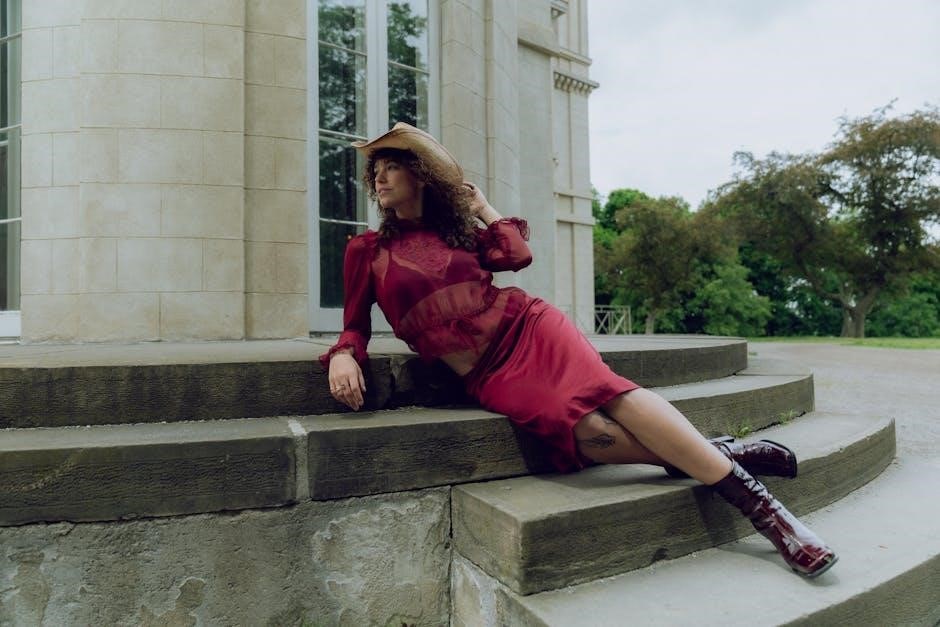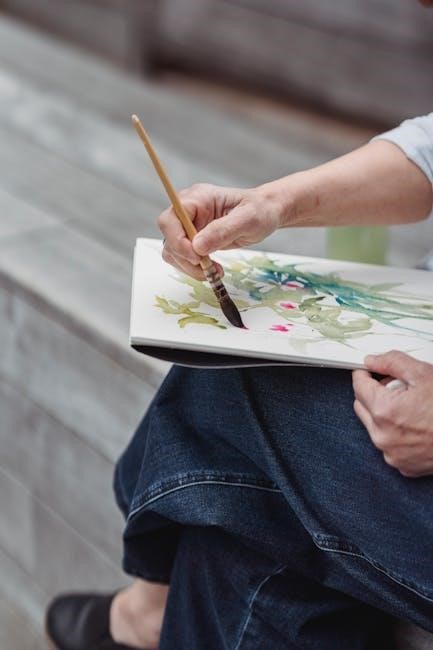
Welcome to the vibrant world of face painting! This step-by-step guide is perfect for all skill levels, offering creative techniques and inspiration for every occasion.
1.1. Welcome to the World of Face Painting
Face painting is a vibrant and creative art form that transforms faces into stunning works of art. Perfect for beginners and professionals alike, it offers endless possibilities for self-expression. Whether for festivals, parties, or everyday fun, face painting brings joy and creativity to all ages. Dive into this step-by-step guide to explore techniques, tips, and designs that will inspire your artistic journey.
1.2. Purpose of the Guide
This guide is designed to provide a comprehensive, step-by-step approach to face painting, offering tips, techniques, and inspiration for all skill levels. Whether you’re a beginner or an experienced artist, this guide will help you master essential techniques, build confidence, and create stunning designs. Perfect for festivals, parties, or everyday fun, it empowers you to unlock your creativity and achieve professional-looking results with ease.

Gathering Your Supplies
Start with essential tools: sponges, brushes, and non-toxic face paints. Choose brands like Wolfe FX or Kryvaline for vibrant, long-lasting results. Don’t forget water and a palette!
2.1. Essential Face Painting Tools: Sponges and Brushes
Sponges are perfect for applying base colors and blending, while brushes are ideal for fine details. Choose natural or synthetic sponges and select brushes in various sizes for precision. Invest in high-quality tools to ensure smooth, professional results. Proper care of your tools will extend their lifespan and maintain their performance. Always clean and store them properly after use for optimal results.
2.2. Choosing the Right Face Paints
Selecting high-quality, non-toxic face paints is crucial for safety and vibrant results. Opt for hypoallergenic, water-based options that are easy to remove. Popular brands include Wolfe FX, Kryvaline, and Diamond FX. Ensure paints are FDA-compliant and suitable for sensitive skin. Always read ingredient labels and choose colors that align with your design needs. Properly stored paints will maintain their consistency and performance over time for optimal use.
2.3. Additional Supplies: Water Cup, Palette, and More
Beyond paints and brushes, essential supplies include a water cup for thinning colors, a reusable palette for organizing paints, and paper towels for quick cleanups. A mirror allows the model to view the design. Optional items like stencils or stamp sponges can enhance creativity. Keep these tools within easy reach to streamline your face painting process and ensure a smooth, efficient workflow during sessions.

Basic Face Painting Techniques
Master essential techniques like dabbing with sponges for smooth base colors and using fine brush strokes for details. These skills form the foundation of every design;
3.1. Dabbing with a Sponge
Dabbing with a sponge is a fundamental technique for creating smooth, even base colors. Dip the sponge in paint, gently dab it onto the skin, and spread evenly for a seamless look. This method is ideal for covering large areas quickly and achieving vibrant, consistent results. Light pressure ensures soft, blendable coverage, perfect for backgrounds or full-face designs.
3.2. Fine Brush Strokes for Details
Fine brush strokes are essential for adding intricate details to your designs. Use a thin brush to create sharp lines, outlines, and small features. Hold the brush at an angle for precise control, applying gentle pressure for delicate work. Dark shades like black or dark brown are ideal for creating depth and definition. Practice this technique to master intricate designs and elevate your face painting skills.

Applying the Base Color
Applying the base color sets the foundation for your design. Use thinned paint for smooth coverage and blend edges for a seamless look. Start with light layers for an even finish.
4.1. Selecting the Perfect Base Shade
Choosing the right base shade is crucial for a natural look. Opt for a color that complements the skin tone, such as soft pinks or neutral tones. For vibrant designs, start with a light base to allow layers to pop. Always thin your paints for smooth application, ensuring even coverage. This step sets the foundation for your entire design, so take your time to perfect it.
4.2. Thinning Colors for Smooth Application
Thinning face paints ensures a smooth, even application. Mix a small amount of distilled water with your paint to achieve the perfect consistency. Always test the thinned paint on your wrist for flow and coverage. Avoid over-thinning, as it may reduce pigmentation. Use a spray bottle to maintain moisture and blend colors seamlessly.

Adding Shading and Blush
Enhance your design with shading and blush for depth and dimension. Use darker shades to create shadows and blend softly for a natural, polished finish.
5.1. Using Darker Shades for Depth
Using darker shades adds depth to your face painting designs. Apply these shades to areas where shadows naturally fall, such as under the jawline or around the eyes. Thinning the paint ensures smooth application and prevents harsh lines. Blend gently with a sponge or brush to create a seamless transition, enhancing the overall dimension of your artwork.
5.2. Blending Techniques for a Natural Look
Blending is essential for creating a natural, seamless appearance in face painting. Use a damp sponge or soft brush to merge colors gently, avoiding harsh lines. Apply thin layers and blend as you go to achieve a smooth transition; This technique is particularly effective for shading and blush, ensuring a soft, realistic finish that enhances the overall design without looking artificial.
Quick and Easy Designs
Quick and easy designs are perfect for beginners and professionals alike. Simple shapes like hearts, stars, or stripes create stunning looks with minimal supplies and effort.
6.1. Butterfly Face Painting Step-by-Step
Start with a base color using a sponge, applying soft shades to the cheek area. Use a fine brush to outline wing shapes and add details like antennae. Fill in the wings with vibrant colors, blending edges for a natural look. Add shading with darker tones for depth and finish with glitter or highlights for a dazzling effect; Practice makes perfect!

Tips for Beginners
Start with simple designs, practice blending techniques, and use high-quality, non-toxic paints. Keep hands steady, watch tutorials, and clean tools regularly for best results. Have fun!
7.1. Practicing with Tutorials
Begin by following step-by-step tutorials to master basic techniques like dabbing and blending. Watch videos or guides to learn how to create smooth transitions and fine details. Start with simple designs, such as butterflies or animals, and gradually move to more complex patterns. Use a beginner’s kit with essential tools and paints to practice confidently. Regular practice will help refine your skills and build creativity.
7.2. Building Confidence with Simple Designs
Start with easy, quick designs like stripes or flowers to build confidence. Use non-toxic paints and basic tools to create clean, bold lines. Practice on friends or family to get feedback. Begin with three essential colors—red, black, and white—to keep it simple. Gradually experiment with more colors as you gain comfort. Each successful design boosts your skill and creativity, making you ready for complex patterns.

Advanced Techniques for Fast Designs
Master speed and creativity with advanced techniques! Learn quick layering, tool hacks, and minimal product use for fast, professional finishes. Practice to perfect these skills for events or gigs.
8.1. Mastering Speed for Large Crowds
Mastering speed is essential for handling large crowds! Simplify designs, use minimal colors, and prep tools in advance. Practice quick layering and blending techniques to achieve professional results fast. Opt for one-stroke brushes and sponges to cover large areas swiftly. Keep designs simple yet impactful, focusing on bold lines and vibrant colors. With practice, you’ll deliver stunning looks in minutes, impressing even the busiest events!
8.2. Impress with Minimal Time and Effort
Impress with minimal time and effort by focusing on simple yet creative designs! Use quick strokes, bold lines, and vibrant colors to create eye-catching looks. Prioritize essential details and skip intricate patterns. Pre-prepped tools and a streamlined palette can save precious minutes. With practice, you’ll deliver stunning results effortlessly, keeping both you and your clients thrilled and satisfied every time!
9.1. Final Tips and Encouragement
Remember, practice is key to mastering face painting. Start with simple designs and gradually experiment with more complex patterns. Don’t be afraid to make mistakes—they’re part of the learning process. Use high-quality, non-toxic paints and keep your workspace clean. Most importantly, have fun and let your creativity shine! Encourage others to join you in this artistic journey.
9.2. Keep Practicing and Have Fun
Keep practicing regularly to refine your skills and explore new techniques. Face painting is a journey—enjoy the process and let creativity flow. Experiment with different designs, colors, and styles to find what you love most. Remember, every design tells a story, so embrace your unique style and share your creations with others. Happy painting!